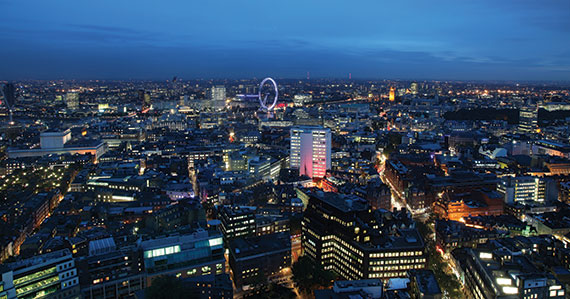
Most agents predict West End office take-up in 2015 will be close to 3.5m sq ft. That is above the 10-year average and a decent, if unremarkable, performance for this stage in the property cycle. However, it is not the volume of deals that stands out but their nature.
According to JLL, more than 30% of deals to date have involved a letting pre-completion, a major swing in a sub-market where, unlike the City, occupiers have traditionally been unwilling to commit to any kind of prelet.
In the past couple of years, the number and size of West End deals agreed while spades were still in the ground has rocketed. The trend has culminated in what is by far 2015’s headline letting: Facebook’s commitment to take 227,324 sq ft at One Rathbone Square, W1, a scheme not due to be delivered until Q4 2017.
It sits alongside other pre-completion lettings – 24,000 sq ft to both Advent International and Egon Zehnder at Land Securities’ Nova Victoria, SW1, and then between them circa 350,000 sq ft to Universal Music and Google at King’s Cross, N1C. While King’s Cross sits outside the traditional West End boundaries it has become a haven for traditional West End occupiers.
These deals join the likes of Estée Lauder, KPMG and The Doctors Laboratory in a wave of occupiers committing to unfinished West End schemes over the past 18 months.
“With so little space available, it is no wonder there has been such an increase in prelet activity,” says Cushman & Wakefield’s Andy Tyler. “West End vacancy rates sit at 2.5% against a 10-year average of 4.7%, and that is very unhealthy. The West End office market is in desperate need of more stock.”
The shortage has not only fuelled rental increases, but forced occupiers to reassess their property strategy. For the more footloose, it has meant migrating to sub-markets with greater supply and lower rents, while those determined to remain in the West End have had to plan further ahead.
Michael Pain, head of Carter Jonas’s tenant advisory team, says: “The Facebook deal is a classic example of a prelet driven by an occupier’s foresight in securing the building they want in a market which offers very little choice. Letting pre-completion is a win-win. The tenant tends to get a better deal and the landlord won’t have to pay for voids.”
Such deals also offer occupiers the potential to affect the way in which office space is delivered. In September 2014, Jupiter Asset Management agreed a deal with Land Securities to take 56,000 sq ft at its Zig Zag Building in Victoria, SW1, which was not due for completion until last month.
A Jupiter spokesman says: “We believe the main advantages to renting space in a building that has yet to be built, lie in the ability to choose the floors that will suit us, while also putting us in a position to have greater input on the fit-out.”
However, such deals come at a cost. Jupiter has taken the hit of double occupancy costs until its lease expires in mid-2016. Others are paying an even higher price. “Facebook, for instance, signed two-and-a-half years before it needed bums on seats,” says Colliers International’s Paul Smith. “Many occupiers with 2018 lease expiries don’t see staying put as an option and, given the lack of availability, are prepared to commit much earlier than they thought they would need to.”
Many of the recent West End prelets have been for large 50,000 sq ft-plus spaces. This is partly because larger businesses are more likely to be able to plan ahead and absorb the effect of double occupancy costs.
It is also a consequence of West End availability, with few schemes able to offer large floorplates.
For some, such as Facebook, the driver for moving is expansion, for others it is the need to improve efficiencies through consolidation.
JLL’s Adrian Crooks says: “Occupiers are buying into the fact that West End supply will be hugely constrained over the next two to three years. A quarter of next year’s supply pipeline is already let or under offer.”
Agents predict a busy last quarter as occupiers snap up the little remaining space. “Demand is healthy right now but no more than that and all we need is an uplift in confidence for limited supply to be very quickly eaten up,” says Tyler.
According to Carter Jonas, rents for prime West End office space have risen by 20% since Q4 2014 and the recent record-breaking letting at 8 St James’s Square, SW1, where The Helly Nahmad Gallery paid a whopping £185 per sq ft, has again shone the spotlight on spiralling occupancy costs.
Yet, headline deals aside, agents agree that demand for the absolute prime space of more than £140 per sq ft is relatively thin and there is no guarantee that West End rents can continue on the same trajectory in the longer term.
Costs in alternative sub-locations such as east London are also rising at a significant rate and the revaluation of rates in 2017 is likely to help narrow the gap between the West End and other sub-markets.
“As rents increase in one location there will always be occupiers who then move out to the next concentric circle, but there will still be plenty of demand for the West End,” insists Deloitte Real Estate partner Stephen Peers. “As Facebook has shown, major organisations still want to be in the centre of town to attract and retain the cream of the crop.”
The question now is whether those occupiers with the will and resources to commit to the West End will take the next leap of faith and consider pure prelets?
“Unlike in the City, where occupiers will look more than two years in advance, West End tenants don’t tend to behave in the same way,” says Peers. “The buildings they want are not generally of the same scale and they prefer to see things coming out of the ground.”
It is also more difficult to find and assemble sites and most agree it would take a seismic shift for the West End to start letting a significant amount of space off plan. Knight Frank’s Ian McCarter says: “I have been doing this for 15 years now and the West End has never done pure prelets. You have got to start construction to attract occupiers and there’s always another option. Facebook signed 18 months ahead of practical completion and what we are likely to see is occupiers prepared to let space much earlier in the construction process.”
Happy days
Lettings during construction are a welcome trend for developers keen to manage risk. Facebook taking 227,324 sq ft at Great Portland Estate’s One Rathbone Square hit the headlines in part because it was agreed more than two years ahead of the building’s completion.
Yet GPE has agreed 10 office pre-completion lettings in the past four years, totalling nearly 800,000 sq ft, as occupiers have become more savvy about their property strategies.
“Back in 2011 and 2012 people seemed to be committing early in order to lock in at lower rents,” says Simon Rowley, GPE’s leasing manager. “Now, particularly given the war for talent, it is more about securing the right stock in a market where supply is very tight.”
Rowley believes a surge in true prelets is unlikely, but welcomes the increased appetite from occupiers to sign up for space while contractors are still on site. The Facebook move has encouraged other occupiers to engage in prelet discussions for other GPE schemes, such as 30 Broadwick Street, W1, due to complete in September 2016
Rowley says: “We have not launched a building speculatively for the past four years. By agreeing these deals we might end up sacrificing some rental value, but we reduce risk and avoid voids. We would not want to be committing to schemes much beyond 2019 because everything is too uncertain.











